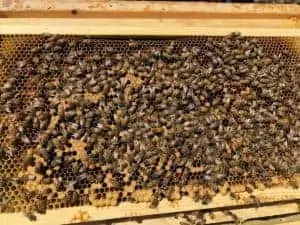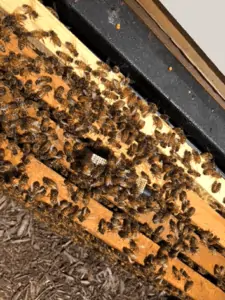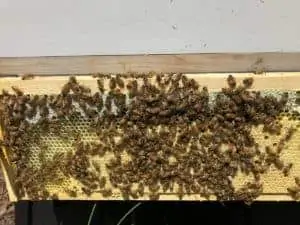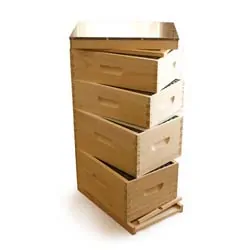Spring weather in western North Carolina can be an ever variable and tricky creature. Such has been the case with the first couple of weeks of April. My last inspection came at the end of March and was right before a week long cooldown that kept me out of the apiary and wondering about progress. We have returned to normal spring weather this week which gave me a chance to make some interesting discoveries. So, I’m sure you’re curious and would love to here what is developing in my apiary.
Hive Updates
Early this week, I switched out my bottle feeders with my hive top feeders. The weather was warming and the bees were rising up in the hive making them very likely to rise into the top hive feeder. I mixed up a 1:1 sugar syrup laced with Honey-B-Healthy, Super Plus, Vitamin B Healthy, and Amino B Booster. I have found that the bees seem to really love the spearmint and I notice that it stimulates brood production in my hives.
While I was placing the top hive feeder on Hive Florence, I decided to check to see what was going on in the medium box. I found what I thought were swarm cells on the bottoms of the frames but they were empty. However, there were a couple of occupied supersedure queen cups which were occupied. Unfortunately, they were connected to some brace comb that the bees had built between the medium and deep boxes and were torn open. I was instantly worried that these might actually have been swarm cells and decided that I had to do a full inspection the next day (more on that below).
Right after getting the hive top feeders positioned, I noticed a voicemail from the local bee shop informing me that the replacement queens I had reserved were in and ready for pickup. The next morning I drove over and picked the queens up, one Carniolan queen and one VSH Italian queen. I brought them back home and readied myself for hive inspections.
Hive Florence
Hive Florence has struggled after the Varroa Mite explosion that I discovered in December. They are definitely still my weakest colony. With the discovery of a well-formed queen cup with a developing larvae, I was curious just what I was going to find in the hive.
The medium box revealed a significant amount of honey having been eaten by the colony from the ten frames of honey that I left in place at the last inspection of last season. There was additional some brood in the medium frames, but not very much. I also couldn’t locate Beatrice. I had suspicions that all was not well with Beatrice but thought it best to give her a chance, especially since I knew I had replacement queens ordered just in case.
With miniscule brood discovered in the medium box as well as no presence of the queen, I moved down into the brood box to see what I might discover. I did discover small amounts of brood, definitely not the amount of brood a healthy queen would provide at this time of the year. What’s more, the brood pattern looked horrible. The laying pattern was haphazard with many holes and there was a preponderance of capped drone cells peppered in between worker brood. You can see this in the image I took of one of the frames. You might have to zoom in to see the details but it wasn’t pretty.
I knew looking at a couple of frames like this that Beatrice was definitely failing. I found her wandering on one of the brood frames with no attendants. She wasn’t even really actively searching cells in which to lay eggs. While I was working the hive, I had placed the Carniolan queen’s cage on top of the frames to get a feel for how the workers might react to her. They gravitated to her instantly and were actively trying to feed her through the cage. It was clear they were recognizing a healthy queen and were ready to learn more.
Regicide?
My co-workers were following my progress as I had told them I was having to take emergency measures. So, one of them asked if we were about to have a regicide. Unfortunately, we did have a regicide. I found the queen and took her off the frame. I thanked her for her hard work last season and then killed her. I felt really terrible crushing such a beautiful queen but it was a necessary task.
The workers in the hive were already trying to replace her and they would have done it for me soon. Her demise was quick and then I returned my attention to the colony. I positioned the queen cage between two frames and then began repositioning the frames.
I placed the medium box back atop the brood box and replaced the hive top feeder. It is a real feat of balance to get a full hive top feeder back on the colony without spilling it all over you, the bees, the hive, and the ground but I did it!) I closed up the colony and will leave it closed for the next few days to give the bees time to accept their new queen.
So, since Beatrice has departed, I decided that I would honor her by retiring the name for this colony and choosing a new name. The new Carniolan queen will be called Lucrezia after the infamous Lucrezia Borgia. I will try to get a good picture of her when I mark her next week. Having had experience with a Carniolan queen last season, I know how quickly this race of bees can build up. So, I’m looking forward to seeing what Lucrezia can bring to this colony.
Hive Rome
Hive Rome has only been in its new home a couple of weeks now but boy had they settled into place quickly! I noted immediately that they were less aggressive than they had been in the nucleus hive. Of course, they didn’t let me get away entirely unscathed as one of them stung me on the top of my hand.
After removing the hive top feeder, I began examining the medium frames. The workers had built some cross and brace comb between the medium and brood box frames which had some eggs and larvae in place. All of that was removed and the wax cleared of larvae (I’m harvesting the wax and have enough now that I need to melt it down.).
Cornelia had been busy laying some brood in the medium frames but much of the brood that had been there had emerged already. She wasn’t to be found in the medium frames which still contain a significant amount of honey stores.
Moving into the brood box, I started seeing just what we want to see during Spring in the apiary. Frames full of brood. One frame was almost wall to wall eggs, larvae and capped brood.
Unfortunately, despite what I didn’t think was cramped conditions, this colony was building swarm cups and there were occupied cells. They were early in production and most were in the brace comb region. I decided that I would perform a split of this colony.
Performing a Split
So since I had a replacement queen available, I decided to remove Cornelia from this colony and form a split with her. I was curious how the colony would react to the replacement VSH Italian queen. I placed the queen cage atop the frames of the brood box to see how the bees would react. I was afraid they would attempt to ball the queen or try to sting her. They were very interested in her but did not attempt to ball her or sting her. In fact, they were actively trying to feed her through the cage.
So, I began my work of splitting the hive. I took three frames of brood and two frames of pollen and honey. I also shook nurse bees off a couple of frames of the hive into the nucleus box and then placed a hive top feeder on top of the nuc and closed it up. I returned to Hive Rome and began rebuilding the colony.
Having removed five frames to complete the split, I replaced the frames with five new frames with no drawn comb. These steps should make the colony think it has swarmed and will focus on rebuilding. I replaced the medium box and put the top hive feeder back in place (I wasn’t as successful at not spilling any on this attempt).
With the split performed and Hive Rome closed up, I moved on to the next colony. I’ll be checking back in a few days to see if the queen has been released and accepted.
Hive Acquitaine
Hive Acquitaine is a busy hive. During foraging hours, there is a steady stream of workers coming and going with workers coming in laden with different colors of pollen. This colony is strong.
It was strong going into fall and winter. It held that strength, despite the Varroa Mites. And it has exploded in population with the Spring. I was interested to see if this hive was ready to swarm.
Examining the medium box revealed a solid amount of brood in the medium box and the honey stores that were left for winter were largely gone but not entirely exhausted. As I have begun feeding, I am not concerned that the honey stores have been significantly used. They served their purposes and the bees will build it back as more and more flowers make their appearances.
As I moved into the deep box, I started finding deep frames with near wall-to-wall brood patterns. The bumpiness of Hive Florence is not in evidence in this colony. The brood pattern is largely unbroken and consists of the normal arrangement with drone brood being either near the top or bottom of the frames.
The population in this colony has increased over the course of the last month and a half. But, I was surprised to find no evidence of swarming intentions yet. So, to forestall that potentiality, I placed a second deep brood box in place atop the bottom brood box. This will give Eleanor all the space she needs to create a full population explosion as we approach the first honey flow of the season. However, I will have to split this hive at some point in the next few weeks.
The population is simply growing too fast for comfort. I intend to create a second nucleus from this colony with eggs and brood to allow them to raise a queen from Eleanor’s genetics. She has been a solid queen and shows no signs of failing. I also hope to raise a couple of queens from this colony in a queen castle.
Nucleus Colony
Since Hive Rome was showing signs of swarming, I made the split by moving Cornelia, the mated queen into the nuc with three frames of brood and two frames of food. She has plenty of space to begin ramping up a new colony. I hope that she will be successfully build up a strong nuc.
I am monitoring this new colony for the aggressiveness that I experienced with her first nucleus colony. If I see that aggressiveness returning, I will kill her and allow the bees to raise a new queen. I would like to build this colony up and sell it.
Preparing for a New Hive
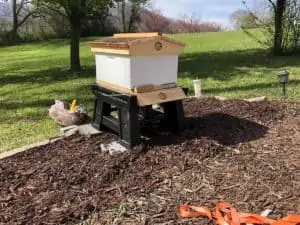
So with three hives already and a new nucleus hive in place, it was time to prepare for my fourth hive this weekend. I added on to my apiary by seating a new hive stand and deep box in the apiary. This week I have a new nuc arriving that I purchased way back in January. That seems like an age ago now.
This week I will get to work with my first colony of Buckfast bees. I’m rather excited to see what these bees are like. From my reading, I’ve learned that Buckfast bees tend to be great honey producers which makes me curious as to how fast the colony will build up. I’ll try to get some pictures taken while I’m installing the new colony. And, I’ll certainly be blogging about this colony.
I’ve decided to name this colony, Hive Asgard and its queen will be named Freya. Stay tuned for news about this new adventure.
Coming Soon
There are lots of developments in my apiary right now and seeing all three of my hives showing growth has been gratifying. I also enjoyed just sitting by Hive Acquitaine on Saturday and just letting the bees fly in to the hive around my head. They were buzzing busily and bringing in lots of pollen.
I have to admit it was very soothing to just sit, listen and watch! For my next blog, I hope to be able to share some observations about the Buckfast bees and talk a little bit about the VSH traits in honeybees and how VSH genetics have been augmented in queens.
Until Next Time, Happy Beekeeping!

